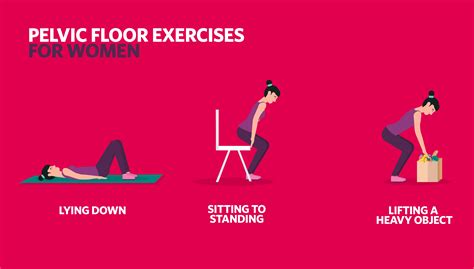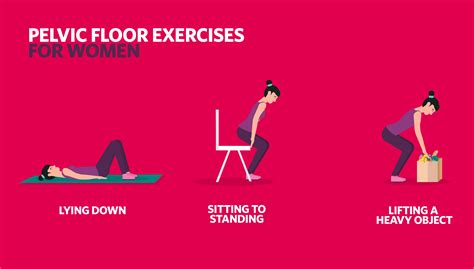Intro
Strengthen your core with 5 tips on pelvic floor exercises during pregnancy, improving bladder control, reducing prenatal discomfort, and enhancing postpartum recovery with Kegel exercises and prenatal yoga.
During pregnancy, women experience numerous physical changes that can affect their overall health and well-being. One crucial aspect of prenatal care is maintaining a strong pelvic floor, which plays a vital role in supporting the bladder, uterus, and bowels. A weak pelvic floor can lead to issues such as incontinence, prolapse, and discomfort during pregnancy and after childbirth. Pelvic floor exercises, also known as Kegel exercises, are essential for pregnant women to strengthen their pelvic muscles and prevent these problems.
Pregnancy is a unique time in a woman's life, and it's essential to prioritize pelvic floor health to ensure a smooth and healthy pregnancy. By incorporating pelvic floor exercises into their daily routine, pregnant women can reduce the risk of complications and improve their overall quality of life. In this article, we will explore the importance of pelvic floor exercises during pregnancy and provide valuable tips on how to perform them effectively.
The benefits of pelvic floor exercises during pregnancy are numerous. They can help alleviate symptoms of incontinence, reduce the risk of prolapse, and improve overall bladder control. Additionally, strong pelvic floor muscles can enhance the pushing process during labor, making it easier and less painful. It's essential for pregnant women to understand the significance of pelvic floor exercises and incorporate them into their daily routine.
Pelvic Floor Anatomy and Function

Benefits of Pelvic Floor Exercises
Pelvic floor exercises offer numerous benefits for pregnant women, including: * Improved bladder control and reduced risk of incontinence * Enhanced support for the pelvic organs, reducing the risk of prolapse * Easier and less painful labor and delivery * Reduced risk of postpartum complications, such as incontinence and prolapse * Improved overall pelvic floor health and well-being5 Tips for Pelvic Floor Exercises During Pregnancy

Common Mistakes to Avoid
When performing pelvic floor exercises, it's essential to avoid common mistakes that can reduce their effectiveness or cause discomfort. These include: * **Squeezing the wrong muscles**: Make sure to squeeze the pelvic muscles, not the abdominal or gluteal muscles. * **Holding your breath**: Breathe naturally while performing pelvic floor exercises to avoid discomfort and dizziness. * **Overexerting**: Don't overexert yourself, as this can cause fatigue and discomfort.Additional Tips for Pelvic Floor Health During Pregnancy

Pelvic Floor Exercises After Pregnancy
After pregnancy, it's essential to continue practicing pelvic floor exercises to maintain pelvic floor health and prevent complications. This is especially important after a vaginal delivery, as the pelvic floor muscles may be weakened. By continuing to practice pelvic floor exercises, new mothers can reduce the risk of incontinence, prolapse, and other complications.Pelvic Floor Exercises and Labor

Benefits for Partners and Support Persons
Pelvic floor exercises can also benefit partners and support persons, who can play a vital role in encouraging and supporting pregnant women in their exercise routine. By understanding the importance of pelvic floor exercises, partners and support persons can help create a supportive environment that promotes overall health and well-being.Pelvic Floor Exercises and Mental Health

Conclusion and Next Steps
In conclusion, pelvic floor exercises are a vital component of prenatal care, offering numerous benefits for pregnant women. By following the 5 tips outlined in this article and incorporating pelvic floor exercises into their daily routine, pregnant women can reduce the risk of complications, improve overall pelvic floor health, and enhance their quality of life. If you're pregnant or planning to become pregnant, consult with your healthcare provider about incorporating pelvic floor exercises into your prenatal care routine.What are the benefits of pelvic floor exercises during pregnancy?
+Pelvic floor exercises during pregnancy can help alleviate symptoms of incontinence, reduce the risk of prolapse, and improve overall bladder control. They can also enhance the pushing process during labor, making it easier and less painful.
How often should I practice pelvic floor exercises during pregnancy?
+Aim to practice pelvic floor exercises at least 3-4 times a day, with 10-15 repetitions each time. Consistency is key to seeing results and maintaining pelvic floor health.
Can I practice pelvic floor exercises after pregnancy?
+Yes, it's essential to continue practicing pelvic floor exercises after pregnancy to maintain pelvic floor health and prevent complications. This is especially important after a vaginal delivery, as the pelvic floor muscles may be weakened.
